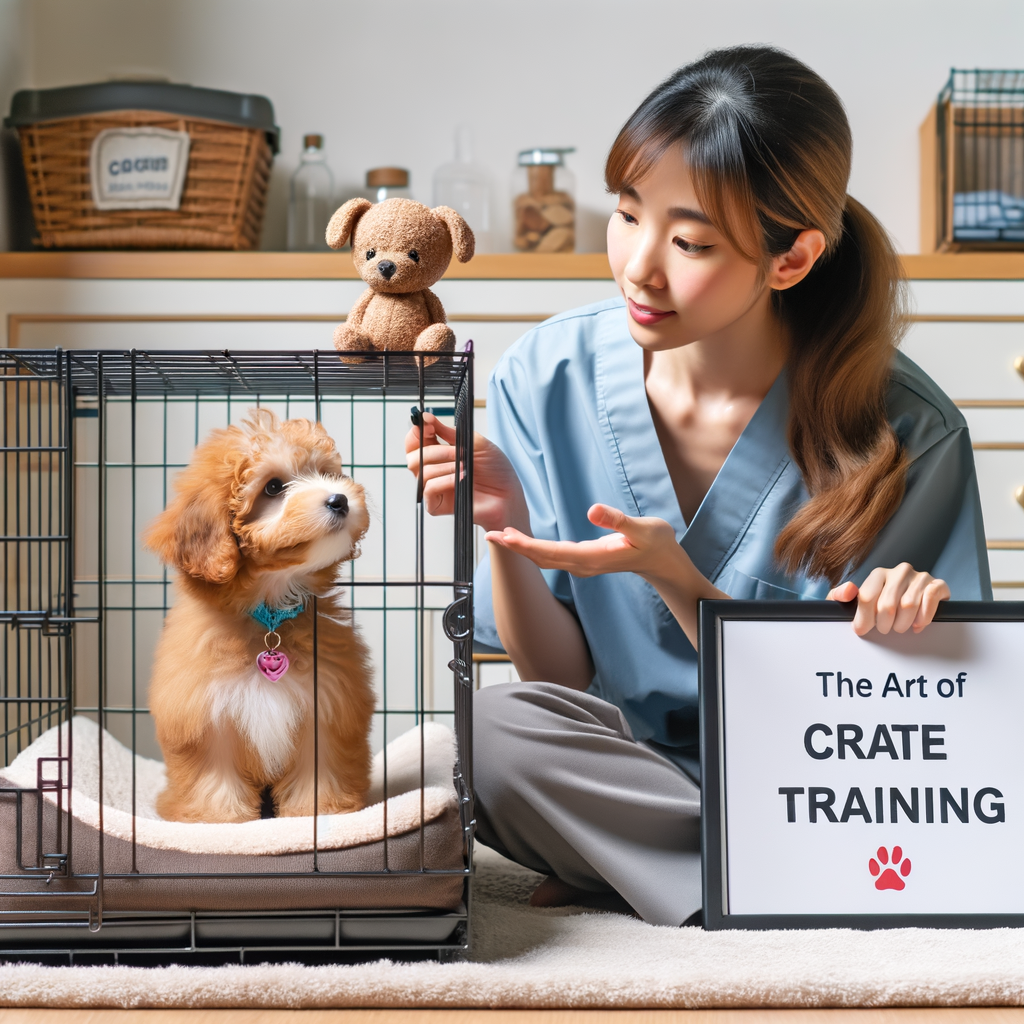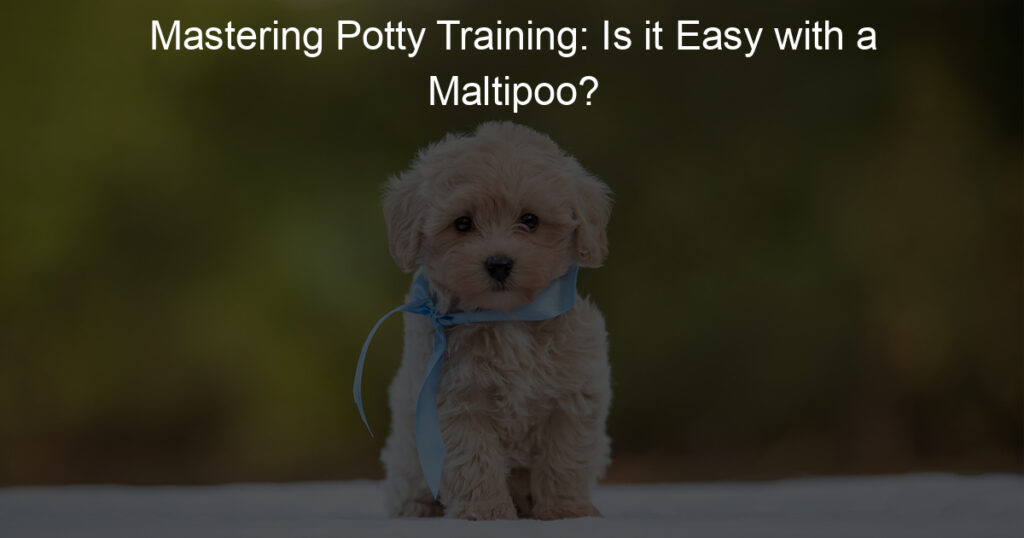
Introduction to Maltipoo Crate Training
Training your Maltipoo can be a fun and rewarding experience. One of the most important aspects of training is crate training. This method is not just about providing a safe space for your pet, but it also plays a crucial role in their overall development and well-being. In this section, we will delve into the importance of crate training and address some common misconceptions.
- Understanding the importance of crate training
- Common misconceptions about crate training
Crate training is a method that uses your dog’s natural instincts as a den animal. A crate can become your Maltipoo’s den, an ideal spot to sleep and retreat when needed. It is also a useful tool for house training, as dogs do not like to soil their dens. This training can help prevent destructive behavior, keep your dog safe, and build a strong bond between you and your pet.
Some people believe that crate training is cruel or that it’s a form of punishment. This is not true. When done correctly, crate training is a safe and effective way to manage your dog’s behavior and help them feel secure. Another misconception is that dogs don’t like crates. In reality, dogs view their crate as their own personal space where they can relax.
In the following sections, we will explore the art of crate training, common challenges, and a step-by-step guide to crate training your Maltipoo. We will also discuss the benefits of crate training and how to master this art. Stay tuned!
The Art of Crate Training
Mastering the art of crate training is a crucial step in ensuring the comfort and happiness of your Maltipoo. It’s not just about confining your pet; it’s about creating a safe space where they can relax and feel secure. Let’s delve into some effective crate training techniques.
Crate Training Techniques
- Choosing the right crate
- Introducing your Maltipoo to the crate
- Gradually increasing crate time
The first step in successful crate training is choosing the right crate. The crate should be large enough for your Maltipoo to stand, turn around, and lie down comfortably, but not so large that they could use one end as a bathroom. A crate that’s too small can cause discomfort and anxiety, while a crate that’s too large can hinder the training process.
Once you’ve chosen the right crate, it’s time to introduce your Maltipoo to it. Start by placing the crate in a common area where your family spends a lot of time. Encourage your Maltipoo to explore the crate on their own by placing treats, toys, or a familiar blanket inside. Remember, the goal is to make the crate feel like a safe and inviting place.
After your Maltipoo has become comfortable with the crate, you can start to gradually increase the amount of time they spend inside. Start with short intervals, like 10 to 15 minutes, and gradually increase the time as your Maltipoo becomes more comfortable. Remember, it’s important to always supervise your Maltipoo while they’re in the crate to ensure they’re safe and comfortable.
By following these techniques, you can help your Maltipoo feel at home in their crate. Remember, patience and consistency are key in successful crate training. It may take time, but the end result is a happy, secure Maltipoo who sees their crate as a safe haven.
Maltipoo Training Tips
Training your Maltipoo can be a rewarding experience for both you and your furry friend. Here are some key tips to keep in mind:
- Using Positive Reinforcement
- Consistency is Key
- Addressing Separation Anxiety
Positive reinforcement is a proven method for training dogs. This approach involves rewarding your Maltipoo for good behavior, which encourages them to repeat it. For example, when your Maltipoo enters the crate willingly, reward them with a treat or praise. This will help them associate the crate with positive experiences.
Consistency is crucial when training your Maltipoo. Make sure to use the same commands and rewards each time. This will help your pet understand what you expect from them. Remember, it’s not just about training sessions – consistency should be maintained throughout the day.
Separation anxiety can be a common issue for Maltipoos. Crate training can help alleviate this anxiety by providing a safe and secure space for your pet. Start by leaving your Maltipoo in the crate for short periods while you are home. Gradually increase the time they spend in the crate, and eventually, they will feel comfortable being alone. Remember, patience is key when addressing separation anxiety.
By following these tips, you can ensure a smooth and successful crate training experience for your Maltipoo. Remember, every dog is unique, so it’s important to be patient and adjust your training methods as needed.
Crate Confessions: Common Challenges in Crate Training
Training your Maltipoo to get accustomed to a crate is not always a walk in the park. It can present several challenges that might leave you feeling frustrated. However, understanding these challenges and knowing how to address them can make the process much smoother. Here are some common issues you might encounter and how to handle them.
Maltipoo Behavior and Crate Training
Maltipoos are known for their playful and affectionate nature. However, when it comes to crate training, they might exhibit certain behaviors that can make the process challenging. Let’s look at some of these behaviors and how to deal with them.
- Dealing with Whining and Barking
- Overcoming Resistance to the Crate
- Addressing Crate Soiling
It’s not uncommon for a Maltipoo to whine or bark when left in a crate. This is usually a sign of separation anxiety. To address this, you can start by leaving your dog in the crate for short periods and gradually increase the time. Always reward your Maltipoo for staying quiet in the crate. This will help them associate the crate with positive experiences.
Some Maltipoos might resist going into the crate. This could be due to a negative association with the crate or simply a dislike for confinement. To overcome this, make the crate a comfortable and inviting place. Add a soft blanket and some of your dog’s favorite toys. You can also feed your Maltipoo in the crate to create a positive association.
If your Maltipoo is soiling the crate, it could be a sign that they’re spending too much time in there. Dogs naturally avoid soiling their sleeping areas. Therefore, ensure your Maltipoo has regular breaks from the crate to relieve themselves. If the problem persists, it might be a good idea to consult a vet or a professional dog trainer.
In conclusion, crate training a Maltipoo can be challenging, but with patience and consistency, you can help your furry friend adjust to their new space. Remember, every dog is unique, and what works for one might not work for another. So, don’t be afraid to try different strategies until you find what works best for your Maltipoo.
Crate Training Your Dog: A Step-by-Step Guide
Training your dog to feel comfortable in a crate is an important part of their development. This guide will provide you with a step-by-step process to help your Maltipoo puppy adapt to crate training.
Maltipoo Puppy Crate Training
Maltipoo puppies, known for their playful and affectionate nature, can benefit greatly from crate training. Here are some key steps to follow:
- Starting early: The best age for crate training
Experts suggest that the best time to start crate training a Maltipoo puppy is between 8 to 16 weeks of age. At this young age, puppies are more adaptable and can easily accept the crate as a safe space.
- Creating a comfortable crate environment
Make the crate a cozy and inviting place for your Maltipoo puppy. Add soft bedding, favorite toys, and even a piece of clothing with your scent. This will help your puppy associate the crate with comfort and security.
- Establishing a crate routine
Consistency is key in crate training. Establish a routine that includes specific crate times such as during meals, nap times, and overnight. This will help your Maltipoo understand when it’s time to be in the crate.
Remember, patience and positive reinforcement are crucial in crate training. Every dog is unique and may take their own time to adjust. But with consistent effort, your Maltipoo puppy will soon see the crate as their own personal safe haven.
The Benefits of Crate Training
Many pet owners may feel unsure about the idea of crate training. However, it’s important to understand the numerous benefits it can offer both you and your Maltipoo. Let’s explore some of these advantages:
- Provides a Safe Space for Your Maltipoo
- Helps with House Training
- Reduces Destructive Behavior
One of the primary benefits of crate training is that it provides a safe and secure space for your Maltipoo. Dogs are naturally den animals, and a crate can serve as their personal den where they can retreat when they feel scared or anxious. It’s like their own little home within your home. This can be especially beneficial during thunderstorms or when you have guests over.
Another significant advantage of crate training is that it can greatly assist with house training. Dogs typically avoid soiling their sleeping areas, so a crate can help teach your Maltipoo to hold it until they’re taken outside. This can make the house training process smoother and faster.
Lastly, crate training can help reduce destructive behavior. When left alone, some dogs may chew on furniture or shoes out of boredom or anxiety. A crate can help manage this behavior by providing a controlled environment where your Maltipoo has access to only chew-friendly toys. This not only protects your belongings but also ensures the safety of your pet.
In conclusion, crate training offers numerous benefits that can enhance the quality of life for both you and your Maltipoo. It’s a valuable tool that can help with house training, reduce destructive behavior, and provide a safe and secure space for your pet.
Conclusion: Mastering the Art of Crate Training
In conclusion, crate training is an essential part of raising a well-behaved Maltipoo. It’s not just about teaching your dog to stay in a crate. It’s about creating a safe and comfortable space for your pet, where they can relax and feel secure. Mastering the art of crate training requires patience, understanding, and a positive approach.
Crate Training Methods: Key Takeaways
Let’s recap the key points we’ve covered in this guide:
- Patience and Consistency: Crate training is not an overnight process. It requires time and patience. Consistency is key. Stick to a regular schedule and make sure all family members follow the same rules.
- Positive Reinforcement: Always reward your Maltipoo for good behavior. Use treats, praise, or toys to make the crate a positive experience. Never use the crate as a punishment.
- Understanding your Maltipoo’s Needs: Every dog is unique. Understand your Maltipoo’s needs and adjust the crate training process accordingly. Some dogs may need more time to adjust, while others may feel comfortable right away.
Remember, the goal of crate training is to make your Maltipoo feel at home in their crate. It’s their personal space, where they can relax and feel safe. With patience, consistency, and a positive approach, you can master the art of crate training and create a happy and secure environment for your pet.








